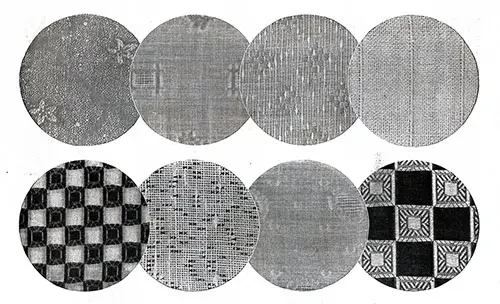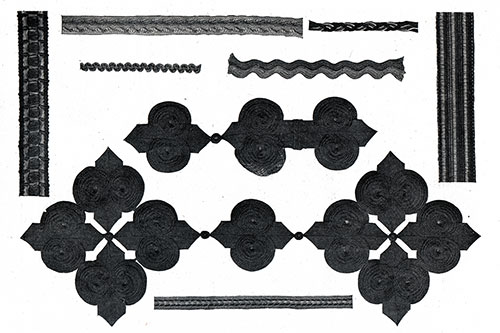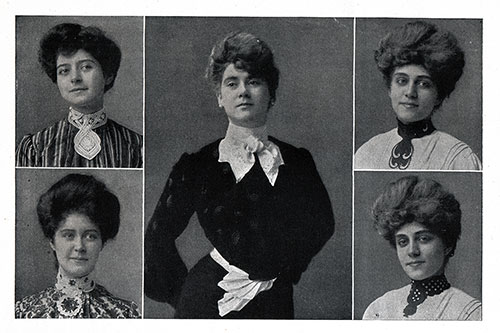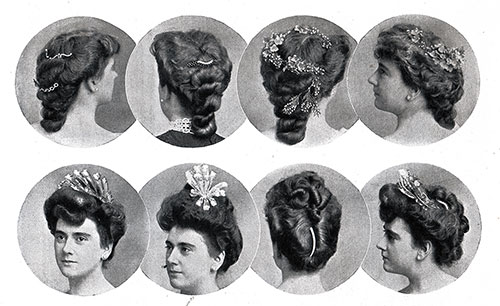Late Winter Dress Materials, Trimmings, and Accessories 1904
With Illustrations of New Vestings, Fiber Braids, Stocks, Etc., and Hair Ornaments

An unusually artistic quality marks many of the present fashions—the colorings are charming; the lines are graceful and even the materials and trimmings are adapted to artistic effects.
As the season has advanced the materials have taken on a softer and more pliable quality, until now even cloth and velvet have acquired the suppleness of chiffon. Heavy, stiff fabrics are impossible to the flowing lines of the present styles.
A distinctly novel weave is termed chiffon-broadcloth, and its possibilities for dressy gowns are unlimited. The surface is lustrous, and the range of colors includes everything approved by Fashion, a rich plum-color being particularly in evidence for the street costume, while for the dressy gown mauve and certain tones of gray are most favored. Indeed, mauve or gray is the choice of the ultra-fashionable, and either is charming in the rich materials.
Too much stress cannot be laid upon the importance of velvet, and the new samples are almost beyond description. Their greatest charm lies in their remarkable suppleness and light weight, and while they have not the richness of the finest velvets of former days, they more than make up for this by the beauty of their coloring and their adaptability to draping, shirring, tucking, etc.
Almost as soft in texture as crepe de Chine are some of these chiffon-velvets. Ideal selections for evening frocks are the pink shades, a delicate peach hue, corn color and pinkish lilac.
Among the fancy varieties are those whose warp is printed in Pompadour bouquets or flower garlands, the coloring of the flowers being faintly blurred by the pile, which is usually white.
Among the darker velvets are all the blues, many beautiful greens and browns, and a wonderful range of violet, fuchsia and dahlia shades. Velvet and fur seem made for comradeship.
There is a subtle harmony between them, and since this is preeminently a velvet season, fur will be much used as trimming. Delightful effects are suggested in the combination.
A beautiful importation was made of a warm brown velvet with trimmings of sable and heavy creamy lace. Another handsome creation was of dahlia-colored velvet with chinchilla as the note of distinction.
The fancy velvets are very popular for day wear. Best liked are the fine striped effects, watered and furry varieties. Among the line weaves of velvet are those that are double the width of the ordinary fabric—a concession to the new full skirts.
A greater innovation than the fur-trimmed velvet frock is the fur-trimmed silk gown, and the idea at once calls to mind the “1830” period, when the silk gowns were worn with fur tippets.
The fullest expression of the picturesque “1830” modes lies in these gowns of silk and fur. Soft taffeta is much in evidence for them, in the one-toned effects preferably, though the shot and changeable silks—of the same soft taffeta weave—are also used; and charming schemes, either in varying shades of one color or in contrasting colors are found.
Louisines in changeable effects are a wise choice. A very pink violet shade shot with white gives beautiful tonings, while a soft dull blue shot with a brown that is almost a deep champagne is an exquisite color harmony. A gown of this silk suggests trimmings of beaver fur or mink.
The new silks are so numerous as to preclude a detailed description. A new weave is called “Sappho,” and while of about the same quality as soft taffeta, it is especially distinguished by a lustrous, satiny finish that is a decided attraction.
A gown recently seen was of this silk in a shade of blue that suggested the hyacinth, and creamy lace was introduced with bands of moleskin fur. The skirt was straight and full from the waist, hanging in soft, graceful lines; at the bottom there were two bands of the fur arranged a slight distance apart around the skirt, and again, about knee-depth, the fur trimming was introduced.
The blouse, of cream lace over chiffon and silk, puffed out from beneath the silk bolero, the edges of which were fur trimmed. Puffs of the lace appeared between slashes made in the silk sleeves, and the most unique touch was the collar and narrow wristbands of the fur; a deep lace frill fell over the hand and a narrow edging of lace softened the effect at the throat.
A deep girdle of panne in exactly the same shades as the silk, provided the last touch of smartness to this visiting or theatre gown. The hat to accompany it carried out the same scheme of color.

Dinner and evening gowns Are fashioned from the curious old-time weaves of taffeta and brocades marked with Pompadour and Dolly Varden patterns in dainty colorings on both white and black grounds. They are delightfully adapted to present styles.
Black gowns of all kinds are very popular for evening, as are also black and white combinations. The lace and net robes glistening with jet sequins are exceptionally good style.
Like a shower of glittering sparks was a robe of black net, made in princess style, with long lobe-shaped spangles falling from the throat to the bottom of the skirt.
The foundation of Ciel-blue taffeta enhanced the beauty of the gown, though any desired color or white or black might be used, and spangled gowns in one color harmony are also seen, as lavender spangles on a lavender net foundation, and the beautiful opalescent spangles on cream net; these have replaced the gold and silver spangles.
Crepe chiffons barred with broad satin bands of self-color or embossed with great bunches of flowers in natural tints, are triumphs of coloring and weaving. Entire gowns as well as the separate blouse will be fashioned from these filmy fabrics.
Street Costumes
In the fashionable woman’s Winter outfit there is no garment of more importance than the street costume, and there are two distinct styles both of which are essential to her up-to-date appearance.
The costume for morning wear must be almost severe in its lines, the skirt escaping the ground all around and the coat preferably in short three-quarter length.
The beautiful silky zibelines and other rough, shaggy fabrics are well liked for these costumes. Corduroys having a wide welt are also fashionable for street suits.
Dark rich shades of brown, green, blue and even very dark reds and gun-metal gray are favored by those of good taste. Cloth of the same shade is frequently introduced in the trimming.
The heavy tub shirt-waists that have been so popular this season will remain in vogue even until the thin, diaphanous creation of mull and other filmy fabrics is revived for the Summer.
The assortment of beautiful mercerized vestings and cheviots has increased until it has become a difficult problem to make selections. There are delightful blues, pinks and' heliotrope shades in these materials, while the white with colored patterns or stripes are extremely stylish. The smartest blouses are in almost tailor severity.
Hats and Bonnets
Military effects are Fashion’s latest fancy and are carried out in the combinations of gold with a color and in the trimming. Green and gold with a touch of black is the favorite combination, and others that are extremely popular are dark blue and gold, bright red and gold, and even brown and gold.
Then there are braids that may be used to outline the seams and finish the edges of the military coat, some having a faint glint of gold in them and others being in plain colors, depending upon gold braid or buttons for the military touch. The military collar and cuffs of velvet or cloth must be trimmed with narrow black, red or gold braid.
Braiding of all kinds is used extravagantly. A favorite is the narrow military variety with very thick ribs, and there are innumerable braids or galloons of silk, chenille, etc., that are indispensable in the fashioning of the stylish gown.
Narrow braids in black and white, or in white and black with a dash of color, are effectively employed, usually in combination with tiny gold, gun metal or silver buttons.

A smart street costume in military style was of dark-green cloth relieved with broad black silk braid, brass bullet buttons and white cloth, the collars and cuffs being of the white cloth, ornamented with narrow black-and-gold braid and tiny brass buttons.
The coat was in double-breasted style and fastened with braid loops and brass buttons. The vents at the sides of the coat and all of the edges were bound with broad black silk braid.
Strappings of the braid were applied to each of the seams in the nine-gored skirt, and a brass button at the top gave a pleasing finish.
Quite military in effect is a dark-blue cloth dress, with a waistcoat of white suede braided in narrow red-and-white braid and trimmed with small gold buttons.
Another pretty military idea is a bodice trimming of wide and narrow braid and tiny gold buttons, around which are laced silk cords finished with gold tips.
Vests of suede matching or harmoniously contrasting with the color of the costume are a feature of the early Spring gowns, bands or applied figures of suede both plain and embroidered appearing upon the skirt also.
Inset pieces of velvet, suede or of cloth, contrasting either in texture or color with the material of the gown, are a favorite method of trimming and are frequently embroidered with some one particular design and carried all through the costume.
Buttons
Perhaps there is nothing in the world of fashion that deserves so much mention as buttons. Some of these are quite as costly as jewels and resemble them in brilliancy.
The large enamel, metal and pearl buttons that are used to adorn handsome wraps are more beautiful than ever before. The gold ball button is in vogue in all sizes, and a profusion of little gold or silk covered buttons is sometimes seen upon a gown.
There are embroidered buttons of rare charm. Oriental silk or embroidery set in metal rings forms gorgeous buttons that give distinction to street frocks of cloth or zibeline in dark colors.
Embroidery
Fancy runs riot in embroideries, and there is a wide range for originality in its disposition upon the gown, blouse or wrap. Hand embroidery in all forms is profusely used, and the broderie anglaise vogue, which was so marked during the past season, has, if anything, increased.
This fancy is expressed now in cloth and in the new soft taffetas, and the embroidery is used for everything from opera coats to petticoats. It is more often seen in combination with plain materials, though charming results are achieved in embroidered taffeta alone.
Now that simplicity of line has assumed such importance the full skirts, with only self-tucks, ruchings or bouillondes for trimming, are quite as well liked as the lace-encrusted, embroidered or appliqué skirts, and the bodice, with its bertha or deep yoke, or surplice, does not of necessity call for extravagant trimming. But to obtain a chic effect good taste must be exercised.
There is a suggestion of the picturesque Watteau period in the draped bodices, lace-trimmed sleeves and bertha that are distinctive features of many of the new gowns.
The high crush girdle, or a simulation of it, is one of the most conspicuous notes of fashion, and it generally assumes a deep sharp point at the bottom in front, though the rounded line is occasionally seen.
The bolero, too, has by no means been discarded. Its becoming outline is too highly appreciated to allow it easily to fall into disfavor.
Dinner and evening gowns of chiffon-velvet in pale, delicate colors are strikingly beautiful when the bunched paillette passementeries in opal or moonlight colorings are used to trim them, and handsome lace is an almost essential accompaniment.
The laces are extremely beautiful, and no gown is complete without lace introduced in some form or other. The most successful novelty in lace is macramé, some samples of which show a deep fringe knotted into the scallops of the lower edge.
Silk fiber laces, with their beautiful sheen, are very popular. They are procurable in all widths in bandings and edgings and may be dyed in any color.
Venetian laces are the trimming par excellence for the handsome velvet gown. Chantilly, Alençon and Valenciennes are the most fashionable of the lighter laces.
Lingerie ruffles are introduced in almost all of the visiting gowns of cloth and velvet; the large flowing sleeves having close-fitting undersleeves, the entire space of the full sleeve being filled in with lace-edged plaitings of fine muslin or chiffon, this being in some cases dyed to match the colorof the gown but presenting a prettier contrast and preserving better the lingerie idea when in the natural ivory or ecru color of the lace.

A cascade of the plaitings falls from the collar down the front of the jacket in the old-fashioned “shirt frill” and is a wonderfully soft framing for a pretty face.
All the Trimmings
A particularly smart trimming for the cloth or velvet gown is the cloth lace which is formed of cut-out designs in cloth filled in by lace stitches in linen, wool or heavy silk threads.
There are bands and motifs of this cut-out cloth which suggest many decorative possibilities. The ingenious modiste will not depend upon the ready-made trimmings but will evolve charming effects from cloth cut in fanciful lengths of fringe, and chiffon, lace and paillettes in the form of pendants hung on silk cords.
There are beautiful ideas in fringes and dangling ornaments, and headings that have lace medallions and disks of gold or silver threads cleverly introduced, while velvet lozenges alternate with arabesque devices in colored beads.
Band trimmings of every description are the order of the day, and unfortunately for those of stout figures many of the newest skirts have these trimmings applied in horizontal effects, with tucks and folds as a finish to the edges.
The fur-trimmed gown is the smartest of the season. Moleskin is the choice of those who can afford the extravagance, and there is a rare charm in this trimming on a white or pale, delicate colored cloth gown. Certain shades of violet and rose also combine well with this fur.
Ermine tails dangling from lace or passementerie ornaments are a trimming that offers many charming effects, and fur cabochons or huge buttons of fur are a novelty worthy of mention. They are used with cords, passementeries, etc.
There are almost unlimited opportunities for fur trimmings in the elaborate evening wraps. These exquisite creations are of velvet, lace, cloth, chiffon and fur. Fringes, too, are used upon these garments, knotted into the heavy laces and into passementeries.
Silk and chenille cords are used effectively, and a novelty consists of silk cords in white or pale tints, finished with clusters of chiffon carnations hanging by their stems.
The little accessories of dress add immeasurably to one’s appearance, and dainty trifles in the way of belts, stocks, bags, fobs, chains, etc., are an absolute necessity.
The neckwear that is displayed in the shops is exceptionally attractive. The variety is not so marked in the shape as in ornamentation and workmanship, and they are all attractive, from the plain tailor modes to the dainty little confections of lace, chiffon and gauzy stuffs.
It would seem that the expression “stole with tab fronts” would describe almost any of these stocks, but each differs from the others in finish.
The taffeta and satin stock, with embroidery or lace medallions as its distinctive feature, is pretty with velvet, silk, cloth and even the heavy wash shirt-waist, while there is nothing quite so charming as the dainty affair of fine linen or batiste, with Mexican drawn work as its ornamental feature. A charming idea is the stock, with belt to match, of soft silk or satin.
Stock collars with stole collar, cuffs and belt to match are sold in sets and really make a complete trimming for a plain blouse or jacket. The material is silk, leather or canvas cloth in white or some very light shade.
Pieces of colored cloth in diamond, square, crescent or other fanciful shapes but all of one color, are applied and connected from one to the other with embroidered figures in solid stitches by scrolls of heavy silk couched on, the whole making a decided pattern upon the foundation material.
After which, the background is strewn with tiny cross stitches rather close together. The entire color scheme is in the dull Oriental shades.
The stole collar docs not reach to the center in the front but leaves a space of two or three inches, and the high stock collar has a single tab which extends between the two ends of the stole.
Woman’s crowning glory is her hair, and she must give much thought to its arrangement and the ornaments used in dressing it. There are innumerable pretty pins and combs that will be worn effectively when the coiffure is dressed either high or low; while for evening and ceremonious occasions there are ornaments that suggest delightful effects.
An especially pleasing idea is the decoration of flowers and foliage. Ornaments of gauze scintillating with varicolored sequins are lovely. Tiny ostrich tips, with an aigrette, are another attractive conceit.
The new combs of oxidized metal set with colored stones are very handsome. They are somewhat different in shape from last season’s style, being wider and without the upward curve; hair slides, too, are seen in the oxidized metal, and there are ivory combs elaborately inset with jewels.
“Late Winter Dress Materials, Trimmings and Accessories with Illustrations of New Vestings, Fiber Braids, Stocks, Etc., and Hair Ornaments,” in The Delineator: An Illustrated Magazine of Literature and Fashion, Paris-London-New York-Toronto: The Butterick Publishing Co. Ltd., Vol. LXIII, No. 2, February 1904, p. 188-191
Editor's Note: Some terminology used in the description of women's clothing during the 1800s and early 1900s has been changed to reflect more modern terms. For example, a women's "Toilette" -- a form of costume or outfit has an entirely different common meaning in the 21st century. Typical terms applied to "toilette" include outfit, ensemble, or costume, depending on context.
